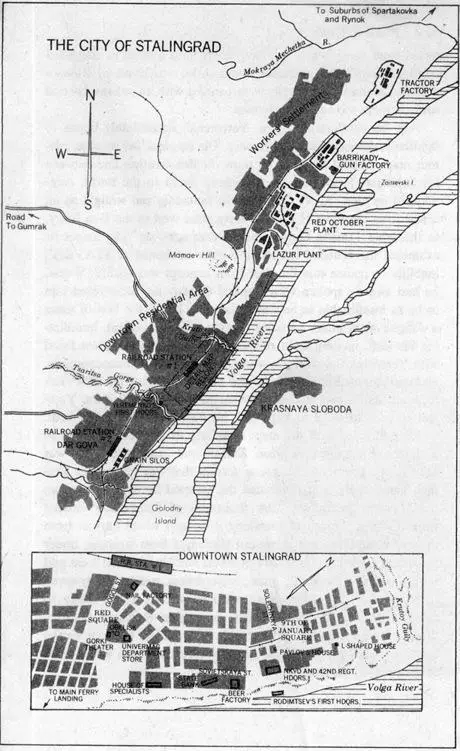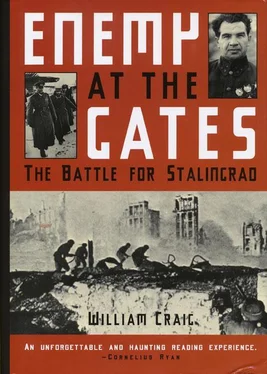When General Yeremenko first looked down on Stalingrad through the window of the plane bringing him to battle, he thrilled at the sight. Hugging the serpentine bends of the Volga, the city looked like a giant caterpillar, sixteen miles long and filled with smokestacks belching forth clouds of soot that told of its value to the Soviet war effort. White buildings sparkled in dazzling sunlight. There were orchards, broad boulevards, spacious public parks. During the drive from the airport through the city, Yeremenko felt himself overwhelmed by the power and charm of the rawboned metropolis.
The general’s underground command post was located in the city’s heart, only five hundred yards away from the western shore of the Volga in the north wall of a two hundred-foot deep, dried-up riverbed called Tsaritsa Gorge. A superb location for a headquarters (some said that it had been built years before on explicit orders from Premier Stalin himself), the bunker had two entrances: one at the bottom of the gorge and the other at the very top, leading into Pushkinskaya Street. Each entrance was protected from bomb blasts by heavy doors, plus a series of staggered reinforced partitions, or baffles. The interior was lavish by Russian military standards. The walls were paneled with an oaken-plywood surface; there was even a flush toilet.
In his comfortable office, Yeremenko immediately began to familiarize himself with his domain. On the desk lay a huge contour map, marked in pencil to show the demarcation line between his Southeast Front and the Stalingrad Front to the north, commanded by Gen. A. V. Gordov. The boundary ran straight as an arrow from the town of Kalach, forty miles west at the Don River, to the same Tsaritsa Gorge where Yeremenko sat. The longer he examined the artificial border, the more he fumed at STAVKA’s inability to realize that the dual-front concept was absurd. Worse, he had already spoken with General Gordov and discovered him to be as insufferable as he was reported to be. In the best of times a difficult man, under pressure Gordov became a tyrant, humiliating his staff, inciting open revolt among subordinates. Now faced with Yeremenko, a rival for power, he was evasive, uncooperative, and unpleasant. But since there was no point waiting for STAVKA to admit its mistake and reassign command responsibilities, Yeremenko tried to come to grips with his own immediate assignment.
He lingered over the map, searching its symbols for clues to a defensive strategy. Between Kalach and Stalingrad there was only steppe country—flat, grassy terrain that was perfect for German panzers. He next eliminated the assorted farms in the region, the kholkozi, where he knew thousands of Stalingrad’s citizens were finishing the job of snatching a bumper wheat harvest from the invaders. The farm crews out there had been straining under the brutal sun while Stuka dive-bombers machine-gunned them and set fire to trains filled with grain. Nevertheless, nearly twenty-seven thousand fully loaded freight cars had already rolled away to safety in the east. Behind them came nine thousand tractors, threshers, and combines along with two million head of cattle, bawling plaintively as they pounded toward the Volga and a swim to the safety of the far shore.

The “harvest victory” was the only one that Yeremenko could savor. Four rings of antitank ditches being dug twenty to thirty miles west of Stalingrad offered little hope. Neither did the “green belt,” a twenty-nine-mile arc of trees planted years before to ward off the effects of dust clouds and snowstorms. Only a mile wide at its thickest point, it could not withstand the concentrated fire of heavy artillery.
Yeremenko’s attention wandered southward, down the map to the rail center of Kotelnikovo, seventy-three miles away. Captured by the Germans on August 2, the city controlled the main road to Stalingrad. The German line of march was obvious: through Chileko, where the Siberian 208th Division had just been decimated by the Luftwaffe, and on to the towns of Krugliakov and Abganerovo. At the latter location, Yeremenko paid closer attention to swirling lines on the contour map indicating hills rising to elevations of from two to three hundred feet. The hills followed the main road the rest of the way to the congested suburbs of Stalingrad. With mounting excitement, he noted deep ravines cutting across the region from east to west and concluded that it would have to be in this twenty-mile strip of hill country that he would try to halt the German advance.
Deep in his heart, however, Yeremenko knew that eventually he would have to fight for Stalingrad block by block and street by street. So, as he pored over the map, he embarked on a peculiar mental exercise: replacing the map’s impersonal symbols with his own images of rock formations, houses, and streets, he strove to understand the battleground he had inherited. The southern part of Stalingrad became a jumble of white wooden homes, surrounded by picket fences and flower gardens. This was Dar Goya, a residential zone just below some light industrial development that crowded close to the Volga—a sugar plant and a massive concrete grain elevator that looked like a gray dreadnought on a prairie sea.
A short distance north of the elevator, the Tsaritsa Gorge cut its two hundred-foot deep scar in the earth before it ran due west for several miles into the steppe. Just above this dividing line was Gordov’s territory, over which Yeremenko had no jurisdiction. But he kept on with his studies, because he intended to be ready when STAVKA came to its senses.
Here was the heart of the city. It encompassed more than one hundred blocks of offices, stores, apartment buildings, and was bounded on the east by the central ferry landing—the only major crossing point on the Volga—plus a promenade along the Volga shore. To the north, it was cut off from the next section of the city by another deep ravine, the Krutoy Gully, and on its western flank was another drab community of single-storey frame houses. Yeremenko sensed immediately that this whole central section of the city could become a fearsome line of defense. Reduced to rubble by gunfire, the fallen bricks and mortar would provide perfect cover for Russian infantry.
The center of town also contained Railroad Station Number One. For months trains had passed through it carrying refugees from other battlegrounds: Leningrad, Odessa, Kharkov. Crammed into cattle cars, when the trains stopped in Stalingrad they jumped off to find water and barter for food with merchants lining the platforms. While they haggled for fruit and bread, the penniless among them stole whatever they could behind the vendors’ backs. But in early August, the motley traffic from other fronts had to share train space with thousands of Stalingrad natives who suddenly had been ordered eastward into Asia by official decree. Now the terminal was swollen to the bursting point with tearful relatives embracing children, old men, and women, amid choked promises to write and keep well. The shrill whistles of the locomotives finally separated the groups. With a last wave and forced smile, a new flood of refugees joined the trek into the vast interior of Russia.
A half block east of the station, the men responsible for the city’s evacuation occupied a five-storey office building on the west side of the shrub-lined Red Square. Across the square, beside the cavernous post office, the newspaper Stalingrad Pravda (“Truth”) still printed a daily edition and distributed it to an anxious reader ship. Under the guidance of the chairman of the City Soviet, Dmitri M. Pigalev, and other members of the council, it published information about air raid drills, rationing, as well as battle reports from the front. To ward off panic, it reported only that the Red Army was scoring impressive victories west of the Don.
Читать дальше













